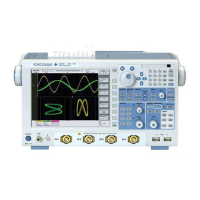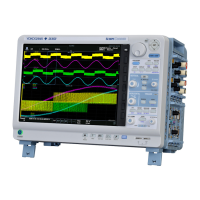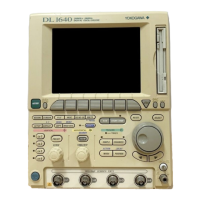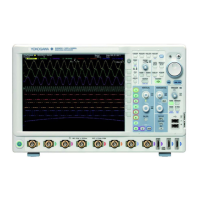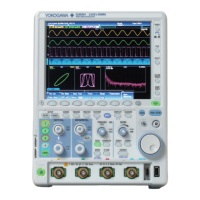5-204
IM 701310-17E
*CAL? (CALibrate)
Function Performs calibration and queries the result.
Syntax
*CAL?
Example
*CAL? -> 0
Description If the calibration terminates normally, 0 is returned. If
an error is detected, 1 is returned.
*CLS (CLear Status)
Function Clears the standard event register, extended event
register, and error queue.
Syntax
*CLS
Example
*CLS
Description
•
If the
*CLS
command is located immediately after
the program message terminator
, the output queue
is also cleared.
• For details on the register and queue, see chapter 6.
*ESE (standard Event Status Enable
register)
Function Sets the standard event enable register or queries
the current setting.
Syntax
*ESE {<NRf>}
*ESE?
<NRf> = 0 to 255
Example
*ESE 251
*ESE? -> 251
Description • Specify the value as a sum of decimal values of
each bit.
• For example, specifying “*ESE 251” will cause the
standard enable register to be set to “11111011.”
In this case, bit 2 of the standard event register is
disabled which means that bit 5 (ESB) of the status
byte register is not set to 1, even if a “query error”
occurs.
• The default value is “*ESE 0” (all bits disabled).
• A query using
*ESE?
will not clear the contents of
the standard event enable register
.
•
For details on the standard event enable register,
see page 6-4.
5.32 Common Command Group
The commands in the common group are defined in the USBTMC-USB488 and are independent of the instrument’s functions.
There are no front panel keys that correspond to the commands in this group.
*ESR? (standard Event Status Register)
Function Queries the standard event register and clears the
register.
Syntax
*ESR?
Example
*ESR? -> 32
Description • A sum of decimal values of each bit is returned.
• You can check what type of events occurred when
an SRQ is generated.
• For example, if a value of “32” is returned, this
indicates that the standard event register is set
to “00100000.” In this case, you can see that the
SRQ occurred due to a “command syntax error.”
• A query using
*ESR?
will clear the contents of the
standard event register
.
•
For details on the standard event register, see
page 6-4.
*IDN? (IDeNtify)
Function Queries the instrument model.
Syntax
*IDN?
Example
*IDN? -> YOKOGAWA,701313,27E100000,
F1.10
Description
The information is returned in the following form:
<Manufacturer>,<Model>,<Serial No.>,<Firmware
version>
The values 701307, 701308, 701310,
70131
1, 701312, and 701313 are returned for
the <Model> when the instrument is the DL9040,
DL9040L, DL9140, DL9140L, DL9240, and DL9240L,
respectively.
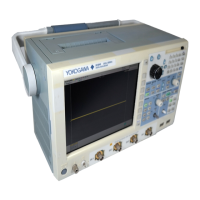
